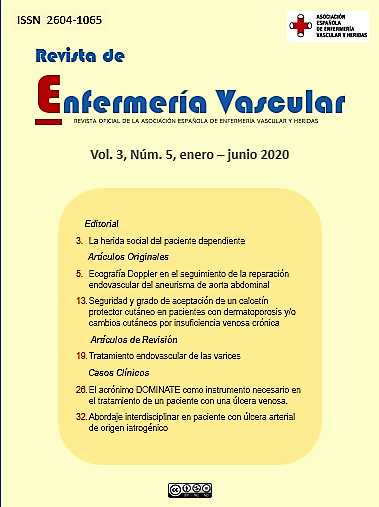Abstract
Among the ulcers of the lower extremity, it is those of venous etiology that occur most frequently. The acronym TIME is often used in the treatment of this type of injury as a tool to help prepare the wound bed. In 2014, with a much more comprehensive view of the care of patients with this type of injury, the acronym DOMINATE was introduced.
This work is developed with the objective of describing the nursing interventions carried out during the treatment (January to May 2019) of a patient with a venous ulcer using the acronym DOMINATE as an ulcer management tool.
In the initial phase of treatment, enzymatic and autolytic cleaning and debridement were performed. Subse-quently, to reduce oedema, manage exudate and facilitate healing, calcium alginate dressings and non-adhesive hy-dropolymeric secondary dressings were used under low elasticity bandages. The cures were held on Mondays, Wednesdays and Fridays.
The monitoring of wound evolution was carried out through photographic records (after informed and written consent of the patient), and in addition the RESVECH scale was used to control the evolution of the lesion, which (which was initially 15 and was decreasing to its full resolution). Overall, the patient’s glycosylated haemoglobin levels dropped from 8.8 to 6.6%, and the pain score (using the EVA scale) went from 5 to 1 in two months.
After the follow-up period we conclude that taking into account all the parameters covered by the acronym DOMINATE is very useful when deciding and planning the care of patients with venous ulcers.
References
Serra R, Grande R, Butrico L, Rossi A, Settimio UF, Caroleo B, et al. Chronic wound infections: The role of Pseudomonas aeruginosa and Staphylococcus aureus. Expert Rev Anti Infect Ther. 2015; 13: 605-13
Marinel.lo Roura J, Verdú Soriano J (Coord.). Conferencia nacional de consenso sobre las úlceras de la extremidad inferior (C.O.N.U.E.I.). Documento de consenso 2018. 2ª ed. Madrid: Ergon; 2018.
Raffetto JD. Pathophysiology of wound healing and alterations in venous leg ulcers-review. Phlebology. 2016; 31(1 Suppl): 56-62.
Asociación Española de Enfermería Vascular y Heridas. Guía de práctica clínica: Consenso sobre úlceras vasculares y pie diabético. Tercera edición. Madrid: AEEVH, 2017. https://www.aeev.net/pdf/Guia-de-Practica-Clinica-web.pdf
Martínez-Morán C, Company-Quiroga J, Alique-García S, Borbujo J. (2017). Etiología de las úlceras de las extremidades inferiores. Piel, 32(5): 273-283. https://doi.org/10.1016/j.piel.2016.11.020
Lozano Sánchez FS, Sánchez Nevárez I, González-Porras JR, Marinel.lo Roura J, et al. Quality of life in patients with chronic venous disease: influence of the socio-demographical and clinical factors. Int. Angiol. 2013;32 (4): 433-441
Nova-Rodríguez JM, Torrado-Velazco KM, Hernández-Moreno ZM, Ariza-Pinto JM, Perez-Hoyos DC, Romero-Díaz PA. Costo-beneficio de la curación avanzada por especialistas en heridas en pacientes con úlcera venosa. Enferm Dermatol. 2018; 12(35): 27-34.
Rezende De Carvalho M, Baptista De Oliveira BGR. Terapia compresiva para el tratamiento de úlceras venosas: una revisión sistemática de la literatura. Enferm. glob. [Internet]. 2017 [citado: 2019 Nov 30] ; 16( 45): 574-633. Disponible en: http://scielo.isciii.es/scielo.php?script=sci_arttext&pid=S1695-61412017000100574&lng=es
Silva, JC. Gestión de cuidado de las personas con úlcera venosa: una revisión integrativa. Cultura de los Cuidados (Edición digital). 2016; 20(46): 147-164. Disponible en: https://rua.ua.es/dspace/bitstream/
/61781/1/CultCuid_46_15.pdf
Stephen-Haynes J. Leg ulceration and wound bed preparation: towards a more holistic framework. Worldwide Wounds. [Internet]. 2007. Disponible en: http://www.worldwidewounds.com/2007/october/Jackie-Stephen-Hayes/test.html
European Wound Management Association (EWMA). Position Document: Wound Bed Preparation in Practice. London: MEP Ltd, 2004. https://ewma.org/fileadmin/user_upload/EWMA.org/Position_documents_2002-2008/pos_doc_English_final_04.pdf
Falanga V. Classifications for wound bed preparation and stimulation of chronic wounds. Wound Repair Regen. 2000; 8(5):347-52.
Gale SS, Lurie F, Treadwell T, Vazquez JA, Carman T, Partsch H, et al. DOMINATE wounds. Wounds. 2014; 26(1):1-12.
Fuentes-Agúndez A, Esparza-Imas G, Morales-Pasamar MJ, Crespo-Villazán L, Nova-Rodríguez JM. “DOMINATE”. Acrónimo de apoyo en la valoración de heridas. Enferm Dermatol. 2016; 10(29):7-11.

This work is licensed under a Creative Commons Attribution-NonCommercial-NoDerivatives 4.0 International License.

